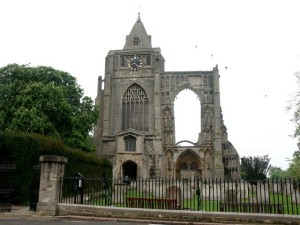In preparation for the joint IES/IHR conference ‘Guthlac of Crowland: Celebrating 1300 Years‘, the IES blog will feature two short posts on the c700 Anglo-Saxon saint.
Romans had already been here and left when, in 699, Guthlac arrived with Tatwin his boatman and Beccelm, a servant, on this remote wedge of gravel in the midst of marsh and wetland, although there were probably local Anglo-Saxon tribesmen, fishing for eels and catching waterfowl.
He established a hermitage, eking out a meagre existence, in such an unhealthy environment, difficult for us to imagine today. There were no roads as we know them, transport was by boat or causeways to neighbouring islands, passible only in the drier months.
 His reputation for piety and good works soon made the small Christian community famous and shortly after his death, Ethelbald, King of Mercia, built a monastery, endowing it with land in the surrounding fens. Guthlac had been taught to read and write, probably by the monks at Repton Abbey, but few others had had this opportunity. Yet over the centuries, local history was systematically recorded, although attacks from Vikings in the 9th and 10th centuries, the Normans and a great fire in the 11th century, an earthquake and second fire in the 12th century resulted in the theft or destruction of most valuable manuscripts.
His reputation for piety and good works soon made the small Christian community famous and shortly after his death, Ethelbald, King of Mercia, built a monastery, endowing it with land in the surrounding fens. Guthlac had been taught to read and write, probably by the monks at Repton Abbey, but few others had had this opportunity. Yet over the centuries, local history was systematically recorded, although attacks from Vikings in the 9th and 10th centuries, the Normans and a great fire in the 11th century, an earthquake and second fire in the 12th century resulted in the theft or destruction of most valuable manuscripts.
Guthlac’s life was recorded by the monk Felix. He lived after the death of Guthlac and had to have relied on stories handed down to him. Another document is Ingulph’s Chronicle which was probably written in the 13th or early 14th century rather than during his lifetime in the 11th century. There is controversy by scholars as to the veracity of both these manuscripts and reasons for discrepancies, if any. Safe to say that stories handed down from generation to generation, play out like a giant game of whispers. However the Guthlac Scroll and the sculptures on the great west front of the Monastery must have been based on this documentation and the latter is among the most important Gothic work in the country.
History has always relied on information handed down from one generation to the next and this has led to a legend of fascinating stories about the town and the lives of the families who, over the centuries, have made their homes here.
–Sybil Speechley, Croyland Abbey, Crowland
Guthlac of Crowland: Celebrating 1300 Years will run 10-11 April 2014 in Senate House, University of London. Click here to register for the conference (£65 standard / £45 concessions).
The conference is supported by the Society for the Study of Medieval Languages and Literatures. Image: Crowland Abbey

